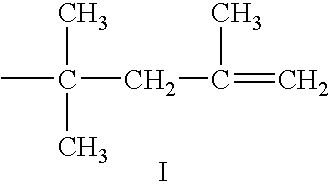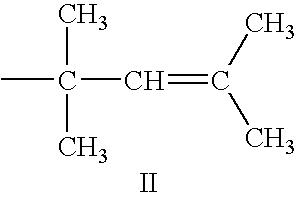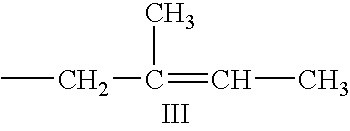Mixed dispersants for lubricants
a technology of lubricant and dispersant, applied in the field of mixing dispersants for lubricants, can solve the problems of increasing the viscosity of lubricant formulations or especially concentrates, severely reducing the anti-wear protection of oil,
- Summary
- Abstract
- Description
- Claims
- Application Information
AI Technical Summary
Problems solved by technology
Method used
Image
Examples
examples
[0063] Syntheses of chlorine-route hydrocarbyl-substituted succinic anhydride. Preparative Example A. Conventional polyisobutene, {overscore (M)}n 2000, prepared using AlCl3 catalyst, 3000 g, and maleic anhydride, 101 g, are added to a 4-neck, 5-L round bottom flask equipped with an overhead stirrer, a thermowell with thermocouple, subsurface gas inlet tube, and appropriate condensers and traps. The mixture is heated, with stirring, to 146° C. Chlorine gas (39.5 g) is added over 5 hours while increasing the temperature to 165° C. The mixture is then heated to 182° C. over 2 hours and maintained at 182° C. for 1 hour. Additional chlorine gas (45.7 g) is added over 5 hours, while increasing the temperature to 193° C. The mixture is further heated to 196° C. and maintained for 5 hours and thereafter at 215° C. for 25 hours with a subsurface nitrogen purge.
[0064] Syntheses of non-chlorine hydrocarbyl-substituted succinic anhydrides. Preparative Example B. To a 4-neck 1 L flask equipped...
examples 1-12
[0070] Dispersants are prepared from mixtures of succinic anhydrides as generally reported in the Preparative Examples above, with varying percentages of the thermal product and the chlorine-process product, as indicated in the following Table 2. Each dispersant composition is in the form of a concentrate containing 45% diluent oil, 55% active chemical. The viscosity of the dispersant composition is reported, as well as the percent increase in viscosity for certain additive concentrate formulations containing the dispersant, after storage for 8 weeks at 65° C.:
TABLE 2Wt %.thermalsuccinicProperties of DispersantVisc increase ofanhydrideppmViscosity,additive conc., %Ex.usedTBNCl100° C., mm2 / sabc 1*e015596465——3.02e2017.4468386——1.03e3018.5408342——0.74e4019.7352333——0.7 5*f011.559350014.75.0—6f2015.164764185.21.0—7f3016.44113834.01.2—8f4017.93473563.2−0.1— 9*g0155964657.90.53.710 g2013.24634066.91.45.211 g3014.34023803.80.84.112 g4013.73363583.41.03.8
*a comparative example
a - additi...
examples 13-20
[0072] Additional dispersants are prepared from mixtures as of the materials of “g” in Table 2, but with CO:N ratio as shown in the footnotes Table 3, and are tested in additive concentrate d. The results of viscosity increase after 8 weeks at 65° C. are reported in Table 3:
TABLE 3Wt %.thermalsuccinicProperties of DispersantVisc, increase, %,anhydrideppmViscosity,of additiveEx.usedTBNCl100° C., mm2 / sconcentrate . . . d13*h014.2283047413.614 h2513.419562429.415 h5011.513391736.816 h7510.6 6801364.317*h1008.4—1175.418*i023.226213309.619 i5017.913671635.020*i10011.5—1224.9
*a comparative example
d - additive concentrate which contains about 46% by weight of the indicated dispersant (including diluent oil) and smaller, conventional amounts of zinc dialkyldithiophosphate, antioxidants, calcium sulfonate detergents, calcium phenate detergent, about 13% additional Cl-route dispersant, besides that indicated in the Table, amide friction modifier, and antifoam agent.
h - dispersant having C...
PUM
| Property | Measurement | Unit |
|---|---|---|
| weight percent | aaaaa | aaaaa |
| weight percent | aaaaa | aaaaa |
| weight percent | aaaaa | aaaaa |
Abstract
Description
Claims
Application Information
 Login to View More
Login to View More - R&D
- Intellectual Property
- Life Sciences
- Materials
- Tech Scout
- Unparalleled Data Quality
- Higher Quality Content
- 60% Fewer Hallucinations
Browse by: Latest US Patents, China's latest patents, Technical Efficacy Thesaurus, Application Domain, Technology Topic, Popular Technical Reports.
© 2025 PatSnap. All rights reserved.Legal|Privacy policy|Modern Slavery Act Transparency Statement|Sitemap|About US| Contact US: help@patsnap.com



